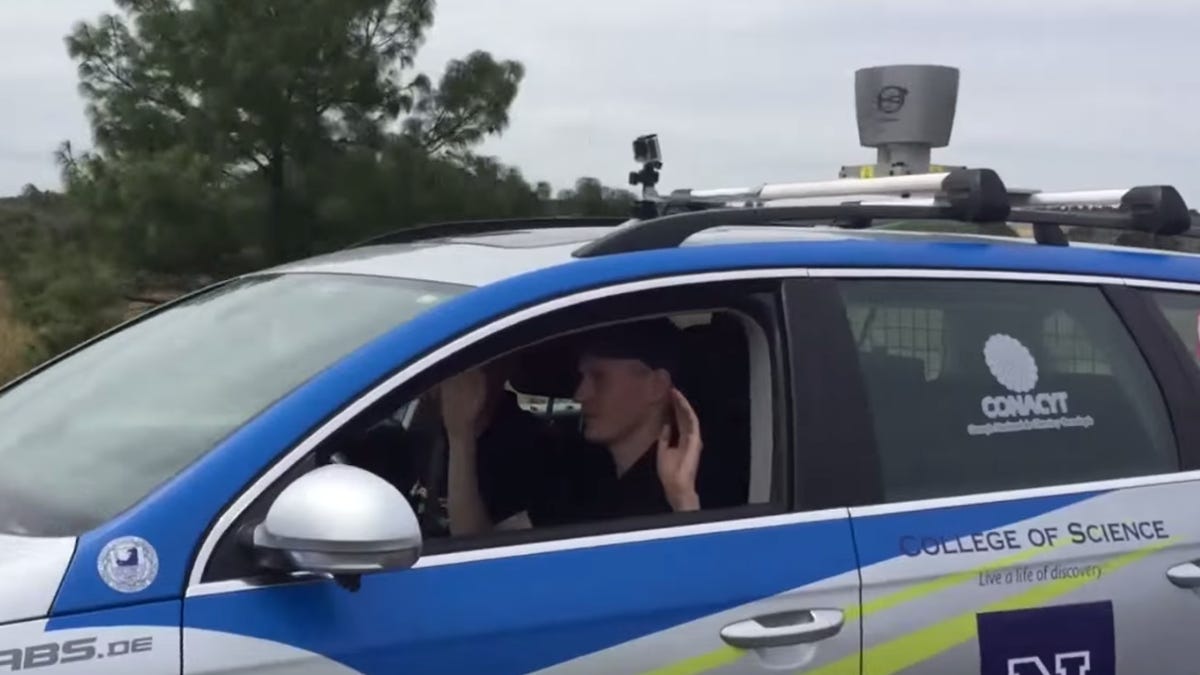Self-driving Volkswagen completes 1,500-mile Mexican trek
A University of Nevada researcher and his colleagues travel hands-free from Nogales to Mexico City, setting a record in the process.

Thankfully, Rojas and his team didn't need to keep their hands raised for the entire trip.
As self-driving vehicles seem to be steering themselves ever closer to the mainstream, a team of researchers has completed Mexico's longest-ever journey in an autonomous car, traveling 1,500 miles in a special high-tech Volkswagen.
Raul Rojas, a professor at the University of Nevada, Reno, led a team that traveled from Nogales to Mexico City this month. The car used for the journey, a 2010 Volkswagen Passat station wagon named Autonomos, was sent to Reno from Berlin, where it's been legal for road testing since 2011.
Autonomos is equipped with seven laser scanners, nine video cameras, seven radars and an incredibly precise GPS unit, all of which were used in various combinations to navigate during the trip. Rojas and company preprogrammed the route into the self-driving software, but the car handled maneuvers like braking and lane changes on the fly.
Autonomos' feat is the latest milestone on the journey toward bringing self-driving vehicles to the general public. In September, details emerged about Apple's reported interest in the market and about Google's efforts to make its self-piloted vehicles behave less like robots and drive more fluidly. In early October, Japanese carmaker Toyota said it planned to have autonomous cars commercially available by 2020. And a year earlier, Tesla Motors CEO Elon Musk said ""="" shortcode="link" asset-type="article" uuid="5291bde9-49dd-4e41-9fb6-8a9c596160fc" slug="elon-musk-sees-autonomous-cars-ready-sooner-than-previously-thought" link-text="we'll see fully autonomous driving in " section="news" title="Elon Musk: Don't fall asleep at the wheel for another 5 years" edition="us" data-key="link_bulk_key" api="{"id":"5291bde9-49dd-4e41-9fb6-8a9c596160fc","slug":"elon-musk-sees-autonomous-cars-ready-sooner-than-previously-thought","contentType":null,"edition":"us","topic":{"slug":"auto-tech"},"metaData":{"typeTitle":null,"hubTopicPathString":"Cars^Auto Tech","reviewType":null},"section":"news"}">
Rojas has worked with intelligent systems since 1986 and with autonomous cars since 2006. His team consisted of two researchers from Freie Universität Berlin and an employee of an autonomous-vehicle research company.
Prior to departure, the crew covered 4,000 miles in and around Nevada, collecting as much data as possible. Afterward, they scrutinized the information to ensure the system was glitch-free. With everything looking good, Rojas headed down to Nogales. For the length of the hands-free journey, he and his party took turns driving, with the remaining team members poring over data coming from the vehicle's autonomous equipment.
The trip went smoothly, with the only issues occurring when the car encountered fresh pavement without lane markings. Despite the "significant issue," as Rojas put it, the car arrived safely in Mexico City approximately one week after its October 12 departure. Autonomos covered between 250 and 300 miles per day.
Though this remains a significant achievement for autonomous driving, Rojas warns we're not ready to roll out these systems to the public just yet.
"Autonomous cars require special maps in order to operate safely, maps in which the number of lanes, the structure of the highway markings and also the position of exits, intersections and possibly of traffic lights are marked," he told a reporter at his university. "Such maps are not commercially available for all countries, and therefore every autonomous car project still has to produce its own maps."
Tesla faced the same struggle when creating its almost-hands-free Autopilot 1.0 system. The automaker had to create very detailed maps to give its vehicles the ability to change lanes and otherwise navigate safely. Autopilot 1.0 recently captured its own record, as a trio of enthusiasts drove from Los Angeles to New York in a Tesla Model S largely free of driver intervention.

